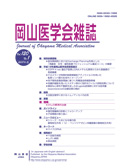

Journal of Okayama Medical Association
Published by Okayama Medical Association<Availability>
Full-text articles are available 3 years after publication.
Permalink : http://escholarship.lib.okayama-u.ac.jp/16404
肺胞マクロファージのスーパーオキサイド産生能に関する研究 第1編 モルモット肺胞マクロファージのスーパーオキサイド産生能に関する研究
上田 明
岡山大学医学部第2内科学教室
発行日
1983-12-30
抄録
During phagocytosis, pulmonary alveolar macrophages(PAM) produce superoxide (O2), which is highly reactive and bactericidal. Therefore, PAM has an important role in the host defense machanisms in the lung. Generally, patient with diabetes mellitus are susceptible to pulmonary infections. It is supposed that a defect in the bactericidal activity of phagocytes is responsible for pulmonary infection. In this experiment superoxide production formed by PAM stimulated with concanavalin A and cytochalasin D was examined in relation to blood glucose concentration and other conditions. Superoxide production by PAM was maximum when the pH was 7.5, the temperature was 37℃, the glucose concentration was 100mg/dl and Ca(++) concentration was 1mM. A glucose concentration of more than 100mg/dl suppressed the superoxide production, and a high glucose level may be related to the high susceptibility of diabetics of pulmonary infections. The energy of superoxide production by PAM depends on both glycolysis and mitochondrial phosphorylation. On the other hand, polymorphonuclear leucocytes mostly depend on glycolysis. The superoxide dismutase(SOD) activity of PAM is remarkably higher than that of polymorphonuclear leucocytes.
キーワード
スーパーオキサイド (superoxide)
SOD (superoxide dismutase)
肺胞マクロファージ (pulmonary alveolar macrophage)
ISSN
0030-1558
NCID
AN00032489
